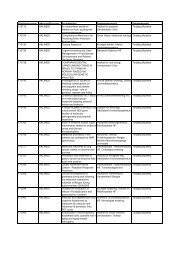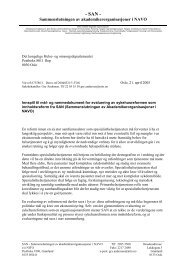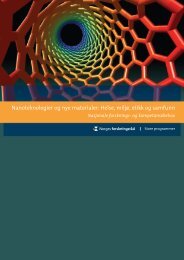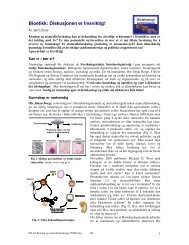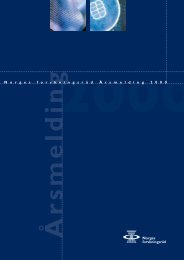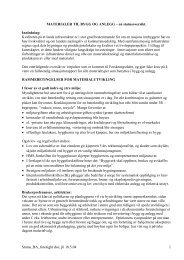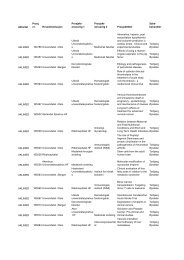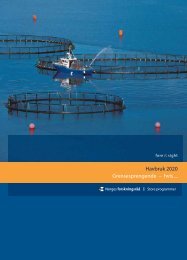Alkylphenols in produced water
Alkylphenols in produced water
Alkylphenols in produced water
You also want an ePaper? Increase the reach of your titles
YUMPU automatically turns print PDFs into web optimized ePapers that Google loves.
Analysis of alkylphenol metabolites<br />
<strong>in</strong> fish bile as a tool<br />
for monitor<strong>in</strong>g <strong>produced</strong> <strong>water</strong> discharges;<br />
a RF-Akvamiljø<br />
b University of Stavanger<br />
Method development and utilisation<br />
Grete Jonsson a , Admira Cavcic b , Tone U. Stokke b ,<br />
Jonny Beyer a and Kåre B. Jørgensen b<br />
Project overview<br />
RF - Akvamiljø<br />
Pollutant exposure and effects <strong>in</strong> fish related<br />
to the discharge of <strong>produced</strong> <strong>water</strong> <strong>in</strong> the<br />
North Sea oil <strong>in</strong>dustry<br />
• WP-1: Fish samples for PW effect assessment<br />
• WP-2: GC/MS detection of alkylphenol metabolites <strong>in</strong> bile<br />
• WP-3: ICP-MS detection of PW metals <strong>in</strong> bile<br />
• WP-4: DNA-biosensor detection of bile genotoxicity<br />
• WP-5: Hepatic biomarkers of PW genotoxicity <strong>in</strong> fish<br />
• WP-6: Endocr<strong>in</strong>e, embryonic and developmental effects<br />
of PW <strong>in</strong> fish<br />
• WP-7: PW effects on thyroid hormones, steroids,<br />
vitam<strong>in</strong> homeostasis and behaviour <strong>in</strong> Atlantic cod<br />
• WP-8: Proteomics analysis of PW exposed fish<br />
Introduction<br />
RF - Akvamiljø<br />
<strong>Alkylphenols</strong> <strong>in</strong> <strong>produced</strong> <strong>water</strong> (PW)<br />
North Sea – Norwegian sector<br />
• >100 mill tons PW released yearly<br />
• 500 tons AP<br />
• C 0 –C 3 AP > 95%<br />
• C 4 –C 7 AP < 5%<br />
RF - Akvamiljø<br />
Introduction<br />
• Toxic<br />
Content<br />
• Project overview<br />
• Introduction<br />
• Exposure of cod to alkylphenols<br />
• HPLC-Fluorescence analysis<br />
• GC-MS analysis<br />
• Summary<br />
Why alkylphenols?<br />
Potentially adverse effects<br />
R. K. Bechmann<br />
Short term exposure<br />
Relatively high exposure concentration<br />
• Hormone disrupt<strong>in</strong>g<br />
Long term exposure<br />
Effect dependent on size and position of alkyl-group<br />
Introduction<br />
Thousands H 3 /g<br />
R. K. Bechmann<br />
RF - Akvamiljø<br />
RF - Akvamiljø<br />
Distribution of 4-t-butylphenol <strong>in</strong> cod<br />
5000<br />
4000<br />
3000<br />
2000<br />
1000<br />
0<br />
From: Sundt and Baussant, 2003<br />
Bile<br />
Liver<br />
Intest<strong>in</strong>e<br />
Intest. cont.<br />
Stomach<br />
Stomach cont.<br />
8 days of <strong>water</strong> exposure<br />
8 days of depuration<br />
Gill<br />
Sk<strong>in</strong><br />
Muscle<br />
Pooled<br />
Gonad<br />
RF - Akvamiljø
Introduction<br />
Proposed metabolism of alkylphenols<br />
Exposure Metabolism Excretion<br />
R<br />
OH<br />
Rox<br />
OH<br />
Phase I<br />
Phase II<br />
Phase II<br />
Rox<br />
R<br />
O-conjugate<br />
O-conjugate<br />
R<br />
OH<br />
Excretion<br />
Excretion<br />
Excretion<br />
RF - Akvamiljø<br />
Target compounds<br />
Representative for alkylphenols <strong>in</strong> <strong>produced</strong> <strong>water</strong><br />
OH OH<br />
CH 3<br />
CH 3<br />
4-methylphenol 2-methylphenol 3,5-dimethylphenol 2,4,6-trimethylphenol<br />
OH<br />
H3C C CH3 CH 3<br />
4-tbutylphenol<br />
Fluorescence ex/em 222/306 nm<br />
OH<br />
H3C C CH3 CH 3<br />
2-methyl-4-tbutylphenol<br />
CH 3<br />
H 3C<br />
OH<br />
OH<br />
C5H11 4-npentylphenol<br />
CH 3<br />
OH<br />
HPLC-F separation<br />
4-MP<br />
2-MP<br />
3,5-DMP<br />
2,4,6-TMP<br />
H 3C<br />
OH<br />
CH 3<br />
OH<br />
CH 3<br />
C6H13 C7H15 4-n4-nhexylphenolheptylphenol<br />
5 45<br />
M<strong>in</strong>utes<br />
Sample: AP mix <strong>in</strong> methanol (≈ 500 µg/l)<br />
Internal standard (IS): 1-Fluoronaphthalene<br />
4-t-BP<br />
4-n-C6P 4-n-C5P 4-n-C7P 4-t-B-2-MP<br />
IS<br />
RF - Akvamiljø<br />
RF - Akvamiljø<br />
Exposure of cod to alkylphenols<br />
Twelve exposure groups: s<strong>in</strong>gle alkylphenols<br />
a mix of n<strong>in</strong>e alkylphenols<br />
carrier control<br />
control<br />
Exposure concentration: 10 mg/kg<br />
Sampl<strong>in</strong>g: Four days after exposure (all groups)<br />
Sixteen days after exposure (five groups)<br />
HPLC-Fluorescence analysis<br />
of alkylphenol metabolites<br />
Sample preparation<br />
Enzymatic treatment<br />
Solid phase extraction<br />
© JB<br />
RF - Akvamiljø<br />
HPLC-separation of a mix of alkylphenols<br />
HPLC-F detection limits<br />
Utilisation<br />
Field exposed fish bile<br />
HPLC-F; <strong>in</strong>strumental LODs<br />
Alkylphenol µg/l<br />
2-methylphenol 1.5<br />
4-methylphenol 2.6<br />
3,5-dimethylphenol 0.5<br />
2,4,6-dimethylphenol 0.6<br />
4-t-butylphenol 1.1<br />
4-t-butyl-2-methylphenol 0.8<br />
4-n-pentylphenol 5.0<br />
4-n-hexylphenol 20.0<br />
4-n-heptylphenol 20.0<br />
LOD (limit of detection) = signal : noise = 3:1<br />
RF - Akvamiljø<br />
RF - Akvamiljø
Fluorescence ex/em 222/306 nm<br />
Bile sample preparation<br />
Sampl<strong>in</strong>g<br />
Non-treated bile<br />
Conjugated metabolites<br />
Chemical analysis<br />
Illustr. Jonny Beyer<br />
Bile treatment Bile treatment<br />
HPLC-F<br />
<strong>Alkylphenols</strong><br />
Impurities<br />
Enzymatic de-conjugation<br />
<strong>Alkylphenols</strong><br />
Oxidized alkylphenols<br />
HPLC-F<br />
GCMS<br />
Sample treatment;<br />
Solid Phase Extraction (SPE)<br />
2: Add sample<br />
1: Condition 3: Wash 4: Elution<br />
HPLC-F analysis of<br />
bile from fish exposed to 4-t-butylphenol<br />
4-t-BP<br />
5 45<br />
M<strong>in</strong>utes<br />
IS<br />
IS<br />
IS<br />
RF - Akvamiljø<br />
RF - Akvamiljø<br />
Standard mix<br />
Conjugated bile<br />
De-conjugated bile<br />
RF - Akvamiljø<br />
De – conjugation of bile<br />
Bile<br />
Enzyme<br />
HO<br />
OH<br />
HO O<br />
H 3C<br />
O<br />
CH 3<br />
O<br />
C OH<br />
CH<br />
Glucuronide conjugated phenol<br />
3<br />
Incubate<br />
2 h at 40°C<br />
H 3C<br />
OH<br />
CH 3<br />
Free phenol<br />
SPE recovery (%)<br />
CH 3<br />
RF - Akvamiljø<br />
Envi- OASIS<br />
Alkylphenol C18 Phenyl Carb MAX<br />
2-methylphenol 88 87 135 ip<br />
4-methylphenol 193* 251* 129* ip<br />
3,5-dimethylphenol 93 72 95 85<br />
2,4,6-dimethylphenol 72 72 44 64<br />
4-t-butylphenol 77 76 99 69<br />
4-t-butyl-2-methylphenol 79 80 96 73<br />
4-n-pentylphenol 95 nd nd 78<br />
4-n-hexylphenol 81 nd nd 94<br />
4-n-heptylphenol 71 nd nd 87<br />
* 4-methylphenol excreted <strong>in</strong> control bile<br />
nd: not determ<strong>in</strong>ed<br />
ip: large <strong>in</strong>terfer<strong>in</strong>g peaks<br />
Fluorescence ex/em 222/306 nm<br />
SPE pack<strong>in</strong>g material<br />
RF - Akvamiljø<br />
HPLC-F analysis of<br />
bile from fish exposed to 4-n-pentylphenol<br />
5 45<br />
M<strong>in</strong>utes<br />
IS<br />
IS<br />
IS<br />
4-n-C 5P<br />
Standard mix<br />
Conjugated bile<br />
De-conjugated bile<br />
RF - Akvamiljø
HPLC-F analysis of<br />
bile from fish exposed to a mix of n<strong>in</strong>e alkylphenols<br />
SIM<br />
Fluorescence ex/em 222/306 nm<br />
Fluorescence ex/em 222/306 nm<br />
8<br />
C 1<br />
C 1 C2<br />
C 3<br />
C 4<br />
IS<br />
IS<br />
Standard mix<br />
Conjugated bile<br />
*<br />
** * *<br />
* IS *<br />
De-conjugated bile<br />
5 M<strong>in</strong>utes<br />
45<br />
C 5<br />
C 5<br />
C 6 C 7<br />
* *<br />
RF - Akvamiljø<br />
HPLC-F analysis of field samples<br />
0 30<br />
M<strong>in</strong>utes<br />
1<br />
2<br />
2<br />
C1 C1 C 1<br />
C 1<br />
3 4<br />
1 3<br />
C 2<br />
C 2<br />
C 3<br />
C 3<br />
C 4<br />
C 4<br />
GC-separation<br />
Time (m<strong>in</strong>)<br />
5<br />
6<br />
TMS-derivatives<br />
10 Time (m<strong>in</strong>)<br />
30<br />
4<br />
5<br />
6<br />
C 5<br />
C 5<br />
Standard mix<br />
German Bight<br />
PW exposed bile<br />
Spiked<br />
PW exposed bile<br />
RF - Akvamiljø<br />
Concentration: ca 1 mg/kg<br />
1: 2-methylphenol<br />
2: 4-methylphenol<br />
3: 3,5-dimethylphenol<br />
4: 2,4,6-trimethylphenol<br />
5: 4-tertbutylphenol<br />
6: 2-methyl-4-tertbutylphenol<br />
30<br />
RF - Akvamiljø<br />
Alkylphenol metabolite concentration<br />
<strong>in</strong> bile from fish exposed to s<strong>in</strong>gle compounds<br />
Concentration (µg/g bile)<br />
200<br />
100<br />
0<br />
n = 4 or 5<br />
2-MP 3,5-DMP 2,4,6-TMP 4-t-B-2-MP<br />
Four days after exposure<br />
Sixteen days after exposure<br />
GC-MS analysis<br />
of alkylphenol metabolites<br />
GC-separation<br />
Sample preparation<br />
Enzymatic treatment<br />
Solid phase extraction<br />
Liquid liquid extraction<br />
Derivatization<br />
RF - Akvamiljø<br />
Derivatized versus underivatized alkylphenols<br />
GC-MS detection limits<br />
Instrumental limits of detection (LOD) pg <strong>in</strong>jected<br />
Phenols TMS-ethers<br />
2-methylphenol 15 0.4<br />
4-methylphenol 40 0.4<br />
3,5-dimethylphenol 10 0.3<br />
2,4,6-trimethylphenol 18 1.3<br />
4-tertbutylphenol 30 1.2<br />
2-methyl-4-tertbutylphenol 15 0.3<br />
RF - Akvamiljø<br />
RF - Akvamiljø
SIM<br />
2-MP<br />
4-MP<br />
IS 1<br />
3,5-DMP<br />
IS 2<br />
GC-separation<br />
Sample: TMS-derivatives of 9 alkylphenols and 5 <strong>in</strong>ternal standards<br />
2,4,6-TMP<br />
4-t-BP<br />
4-t-B-2-MP<br />
IS 4<br />
IS 3<br />
IS 5<br />
4-n-C 7P<br />
4-n-C6P 4-n-C5P 16 Time (m<strong>in</strong>)<br />
46<br />
BSTFA<br />
TMSI<br />
Peak area Derivatization efficiency<br />
Low TMSI Double peaks<br />
for 4-t-butylphenol<br />
Increas<strong>in</strong>g amount of derivatization reagent<br />
Recovery (%)<br />
SPE pack<strong>in</strong>g material: OASIS MAX (anion exchange)<br />
Solvent: Methyl-tertbutylether<br />
RF - Akvamiljø<br />
RF - Akvamiljø<br />
Alkylphenol off-column on-column<br />
derivatization derivatization<br />
2-methylphenol 78 89<br />
4-methylphenol 151 134<br />
3,5-dimethylphenol 94 86<br />
2,4,6-dimethylphenol 22 66<br />
4-t-butylphenol 75 67<br />
4-t-butyl-2-methylphenol 36 69<br />
4-n-pentylphenol 84 86<br />
4-n-hexylphenol 80 87<br />
4-n-heptylphenol 77 80<br />
RF - Akvamiljø<br />
Derivatisation efficiency<br />
Two trimethylsilylation (TMS) reagents tested<br />
BSTFA: Bis(trimethylsilyl)trifluoroacetamide<br />
TMSI: Trimethylsilylimidazole<br />
OH<br />
H3C C CH3 CH 3<br />
+<br />
BSTFA<br />
or<br />
TMSI<br />
2 hours at 60°C<br />
15 m<strong>in</strong> at room temp.<br />
CH 3<br />
H3C Si CH3 O<br />
H3C C CH3 CH 3<br />
RF - Akvamiljø<br />
On- and off-column TMS-derivatization<br />
Off-column<br />
derivatization<br />
On-column derivatization<br />
3: Wash 4: Dry column 5a: Elution 5b: Derivatize 6b: Elution<br />
<strong>Alkylphenols</strong><br />
Derivatized alkylphenols<br />
Impurities<br />
HPLC-F<br />
Summary<br />
6a:<br />
Derivatization<br />
RF - Akvamiljø<br />
• Knowledge about the metabolism of C 1 -C 7 alkylphenols<br />
• Analysis of bile from fish exposed to simple and known<br />
compounds<br />
• Not sufficiently specific for analyses of bile from fish<br />
exposed to complex mixtures (field samples)<br />
RF - Akvamiljø
GC-MS<br />
Summary<br />
• Derivatization improve GC separation<br />
• Derivatization improve detection limits<br />
• On-column derivatization results <strong>in</strong> good recoveries<br />
• On-column derivatization result <strong>in</strong> improved<br />
separation of matrix <strong>in</strong>terferences from alkylphenols<br />
RF - Akvamiljø<br />
Acknowledgement<br />
to<br />
NFR - PROOF<br />
for f<strong>in</strong>ancial support<br />
RF - Akvamiljø



